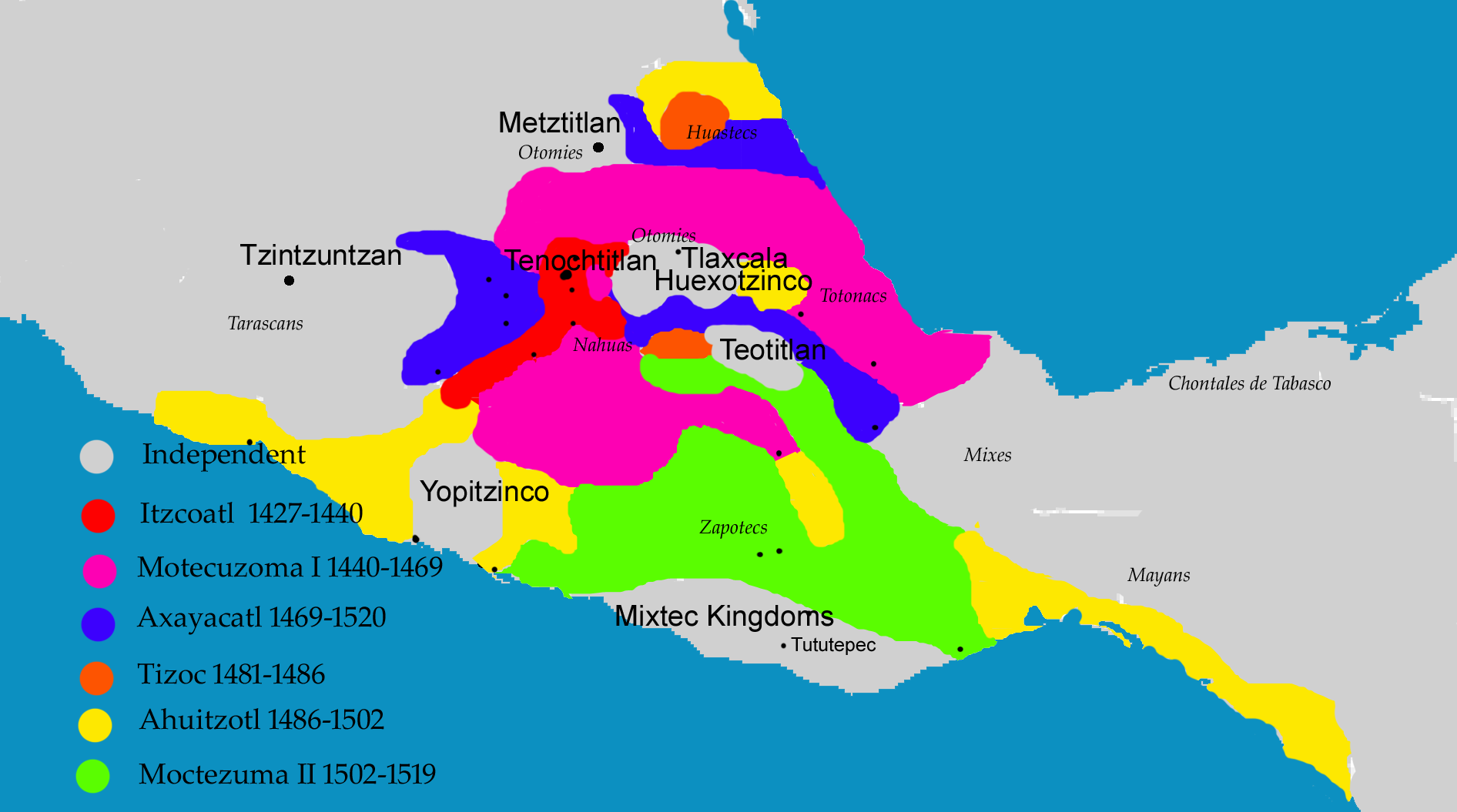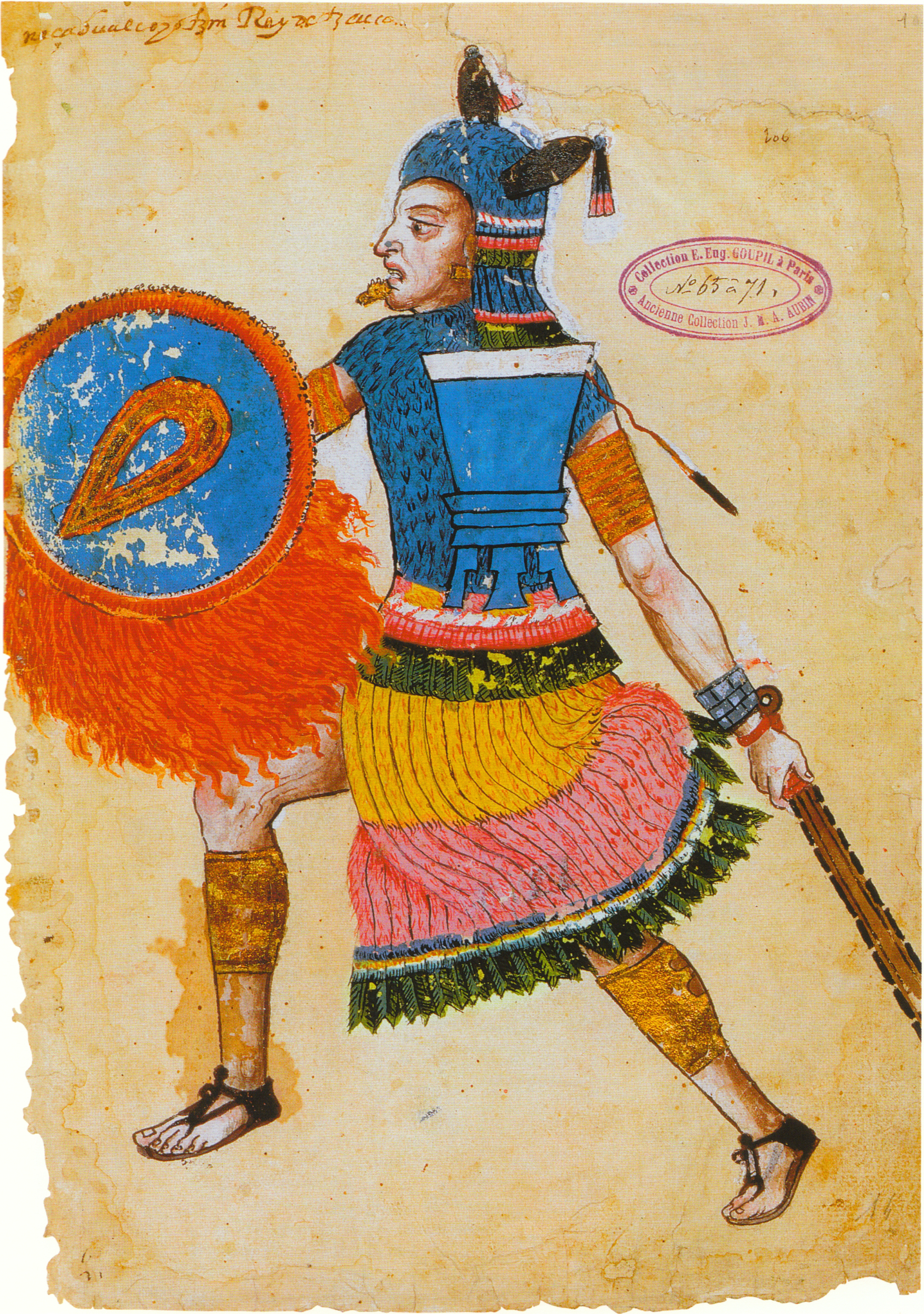|
Quecholcohuatl
Quecholcohuatl was a Chalcan musician. He was known for making peace between his native altepetl of Chalco and Tenochtitlan by serenading its Tlatoani, Axayacatl, in 1479. His song became a multigenerational hit and brought fame to his hometown of Amaquemecan. Chimalpahin, a Nahua annalist, commented that: “Because of it Amaquemecan (Ah-mah-kay-MAY-kahn) was ncefamous, an altepetl which now appears small and unimportant”. His Nahuatl name roughly translated to ''"Flamingo Snake"'' in English, although he later adopted the Christian name, Don Jerónimo, after the Spanish conquest of the Aztec Empire of 1519–21. Making peace The story of how Quecholcohuatl made peace with the tlatoani of Tenochtitlan, Axayacatl, is told in the ''Eight Relations'', an annal written by Chalcan annalist, Chimalpahin. The story features in his Seventh Relation. Chalco was conquered by the Aztec triple-alliance under Moctezuma I in or around 1465, after which the kings of Chalco were exil ... [...More Info...] [...Related Items...] OR: [Wikipedia] [Google] [Baidu] |
Chalco (altépetl)
Chālco was a complex pre-Columbian Nahua '' altepetl'' or confederacy in central Mexico. It was divided into the four sub-altepetl of Tlalmanalco/ Tlacochcalco, Amaquemecan, Tenanco Texopalco Tepopolla and Chimalhuacan-Chalco, which were themselves further subdivided into ''altepetl tlayacatl'', each with its own ''tlatoani'' (king). Its inhabitants were known as the ''Chālcatl'' (singular) or ''Chālcah'' (plural). In the 14th and early 15th centuries, flower wars were fought between the Chalca and the Aztecs. Serious war erupted in 1446. According to the Amaqueme historian Chimalpahin, this was because the Chalca refused a Mexica demand to contribute building materials for the temple of Huitzilopochtli. Chalco was finally conquered by the Aztecs under Moctezuma I in or around 1465, and the kings of Chalco were exiled to Huexotzinco. The rulerships were restored by Tizoc in 1486, who installed new ''tlatoque''. This was achieved, in part, by the diplomacy work car ... [...More Info...] [...Related Items...] OR: [Wikipedia] [Google] [Baidu] |
Hegemony
Hegemony (, , ) is the political, economic, and military predominance of one State (polity), state over other states, either regional or global. In Ancient Greece (ca. 8th BC – AD 6th c.), hegemony denoted the politico-military dominance of the ''hegemon'' city-state over other city-states. In the 19th century, ''hegemony'' denoted the "social or cultural predominance or ascendancy; predominance by one group within a society or milieu" and "a group or regime which exerts undue influence within a society". In theories of imperialism, the hegemonic order dictates the internal politics and the societal character of the subordinate states that constitute the hegemonic sphere of influence, either by an internal, vassal state, sponsored government or by an external, puppet state, installed government. The term ''hegemonism'' denoted the geopolitical and the cultural predominance of one country over other countries, e.g. the hegemony of the Great power, Great Powers established wit ... [...More Info...] [...Related Items...] OR: [Wikipedia] [Google] [Baidu] |
16th-century Male Musicians
The 16th century began with the Julian calendar, Julian year 1501 (represented by the Roman numerals MDI) and ended with either the Julian or the Gregorian calendar, Gregorian year 1600 (MDC), depending on the reckoning used (the Gregorian calendar introduced a lapse of 10 days in October 1582). The Renaissance in Italy and Europe saw the emergence of important artists, authors and scientists, and led to the foundation of important subjects which include accounting and political science. Copernicus proposed the Copernican heliocentrism, heliocentric universe, which was met with strong resistance, and Tycho Brahe refuted the theory of celestial spheres through observational measurement of the SN 1572, 1572 appearance of a Milky Way supernova. These events directly challenged the long-held notion of an immutable universe supported by Ptolemy and Aristotle, and led to major revolutions in astronomy and science. Galileo Galilei became a champion of the new sciences, invented the first ... [...More Info...] [...Related Items...] OR: [Wikipedia] [Google] [Baidu] |
15th-century Musicians
The 15th century was the century which spans the Julian calendar dates from 1 January 1401 (represented by the Roman numerals MCDI) to 31 December 1500 (MD). In Europe, the 15th century includes parts of the Late Middle Ages, the Early Renaissance, and the early modern period. Many technological, social and cultural developments of the 15th century can in retrospect be seen as heralding the "European miracle" of the following centuries. The architectural perspective, and the modern fields which are known today as banking and accounting were founded in Italy. The Hundred Years' War ended with a decisive French victory over the English in the Battle of Castillon. Financial troubles in England following the conflict resulted in the Wars of the Roses, a series of dynastic wars for the throne of England. The conflicts ended with the defeat of Richard III by Henry VII at the Battle of Bosworth Field, establishing the Tudor dynasty in the later part of the century. Constantinop ... [...More Info...] [...Related Items...] OR: [Wikipedia] [Google] [Baidu] |
Tizoc
Tizocic (), or Tizocicatzin (), usually known in English as Tizoc, was the seventh tlatoani of Tenochtitlan, ''tlatoani'' of Tenochtitlan. His name means, "He who makes sacrifices" or "He who does penance." Either Tizoc or his successor Ahuitzotl was the first ''tlatoani'' of Tenochtitlan to assume the title ''Huey Tlatoani'' ("supreme ''tlatoani''") to make their superiority over the other cities in the Triple Alliance (Aztec Empire) clear. Biography Family Tizoc was a son of the princess Atotoztli II and her cousin, prince Tezozomoc (son of Itzcoatl), Tezozomoc. He was a grandson of Emperors Moctezuma I and Itzcoatl. He was a descendant of the King Cuauhtototzin. He was successor of his brother Axayacatl and was succeeded by his other brother, Ahuitzotl; his sister was the Queen Chalchiuhnenetzin, married to Moquihuix, tlatoani of Tlatelolco (altepetl), Tlatelōlco. He was an uncle of Emperors Cuauhtémoc, Moctezuma II and Cuitláhuac and grandfather of Diego de San Francis ... [...More Info...] [...Related Items...] OR: [Wikipedia] [Google] [Baidu] |
Sex Slavery
Sexual slavery and sexual exploitation is an attachment of any ownership right over one or more people with the intent of coercing or otherwise forcing them to engage in sexual activities. This includes forced labor that results in sexual activity, forced marriage and sex trafficking, such as the sexual trafficking of children. Sexual slavery has taken various forms throughout history, including single-owner bondage and ritual servitude linked to religious practices in regions such as Ghana, Togo, and Benin. Moreover, slavery's reach extends beyond explicit sexual exploitation. Instances of non-consensual sexual activity are interwoven with systems designed for primarily non-sexual purposes, as witnessed in the colonization of the Americas. This epoch, characterized by encounters between European explorers and Indigenous peoples, saw forced labor for economic gains and was also marred by the widespread prevalence of non-consensual sexual activities. In unraveling the intr ... [...More Info...] [...Related Items...] OR: [Wikipedia] [Google] [Baidu] |
Valley Of Mexico
The Valley of Mexico (; ), sometimes also called Basin of Mexico, is a highlands plateau in central Mexico. Surrounded by mountains and volcanoes, the Valley of Mexico was a centre for several pre-Columbian civilizations including Teotihuacan, the Toltec, and the Aztec Empire. The valley used to contain five interconnected lakes called Lake Zumpango, Lake Xaltocan (), Lake Xochimilco, Lake Chalco and the largest, Lake Texcoco, covering about of the valley floor. When the Spaniards arrived in the Valley of Mexico, it had one of the highest population concentrations in the world with about one million people. After the conquest of the Aztec Empire, the Spaniards rebuilt the largest and most dominant city, Mēxihco Tenōchtitlan, renaming it ''Ciudad de México'' (Mexico City) and over time began to drain the lakes' waters to control flooding. The Valley of Mexico is located in the Trans-Mexican Volcanic Belt. The valley contains most of the Mexico City metropolitan area, ... [...More Info...] [...Related Items...] OR: [Wikipedia] [Google] [Baidu] |
Texcoco (altepetl)
Tetzcoco (Classical Nahuatl: ''Tetzco(h)co'' , Otomi: ) was a major Acolhua altepetl (city-state) in the central Mexican plateau region of Mesoamerica during the Late Postclassic period of pre-Columbian Mesoamerican chronology. It was situated on the eastern bank of Lake Texcoco in the Valley of Mexico, to the northeast of the Aztec capital, Tenochtitlan. The site of pre-Columbian Tetzcoco is now subsumed by the modern Mexican ''municipio'' of Texcoco and its major settlement, the city formally known as Texcoco de Mora. It also lies within the greater metropolitan area of Mexico City. Pre-Columbian Tetzcoco is most noted for its membership in the Aztec Triple Alliance. At the time of the Spanish conquest of the Aztec Empire, it was one of the largest and most prestigious cities in central Mexico, second only to the Aztec capital, Tenochtitlan. A survey of Mesoamerican cities estimated that pre-conquest Tetzcoco had a population of 24,000+ and occupied an area of 450 h ... [...More Info...] [...Related Items...] OR: [Wikipedia] [Google] [Baidu] |
Acolhua
The Acolhua are a Mesoamerican people who arrived in the Valley of Mexico in or around the year 1200 CE. The Acolhua were a sister culture of the Aztecs (or Mexica) as well as the Tepanec, Chalca, Xochimilca and others. The most important political entity in ancient Mesoamerica was the Triple Alliance (Nahuatl, ''excan tlatoloyan''), founded in 1428 when the rulers of Tenochtitlan, Texcoco, and Tlacopan formed an alliance that replaced the Tepanec Empire of Azcapotzalco and eventually integrated into a single polity the most developed regions of western Mesoamerica. Because of the predominance of Tenochtitlan, it has also been called the Mexica, Aztec, or Tenochca Empire. It came to an end with the Spanish conquest of 1521. Each of the three allied kings led a group of lesser kingdoms that coincided with the three major ethnic components and political powers of previous times: the Colhuas, the Acolhua- Chichimecs, and the Tepanecs. The domain of Tenochtitlan was the sout ... [...More Info...] [...Related Items...] OR: [Wikipedia] [Google] [Baidu] |
Tlacopan
Tlacopan, also called Tacuba, (, ͡ɬaˈkóːpan̥ was a Tepanec / Mexica altepetl on the western shore of Lake Texcoco. The site is today the neighborhood of Tacuba, in Mexico City. Etymology The name comes from Classical Nahuatl ''tlacōtl'', "stem" or "rod" and ''-pan'', "place in or on" and roughly translates to "place on the rods"), History Tlacopan was a Tepanec subordinate city-state to nearby altepetl, Azcapotzalco. In 1428, after its successful conquest of Azcapotzalco, Tlacopan allied with the neighbouring city-states of Tenochtitlan and Texcoco, thus becoming a member of the Aztec Triple Alliance and resulting in the subsequent birth of the Aztec Empire.León-Portilla, M. 1992, 'The Broken Spears: The Aztec Accounts of the Conquest of Mexico.'' Boston: Beacon Press, Aculnahuacatl Tzaqualcatl, the son of the Tepanec ruler, Tezozomoc, was installed as tlatoani of Tlacopan until his death in c.1430. Throughout its existence, Tlacopan was to remain a minor pol ... [...More Info...] [...Related Items...] OR: [Wikipedia] [Google] [Baidu] |





